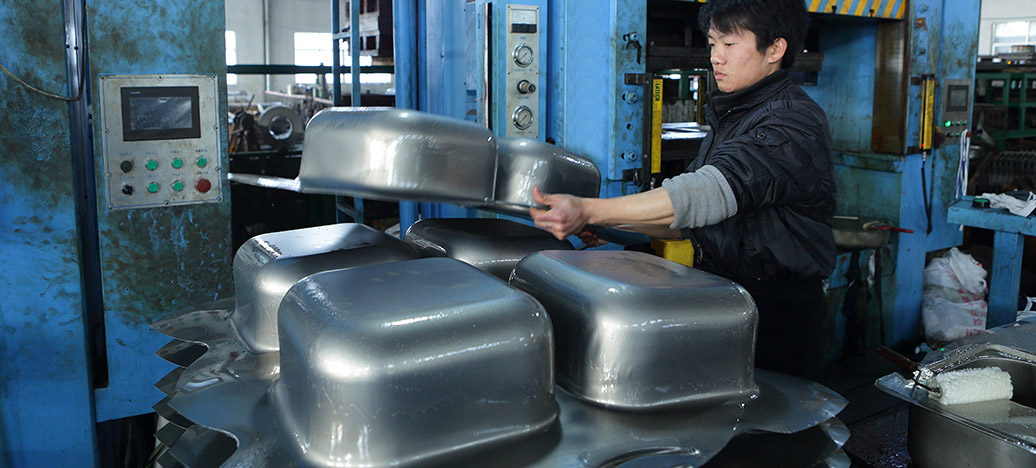The Intricate Process Behind Crafting Premium Stainless Steel Sinks
Stainless steel sinks have become a staple in modern kitchens and bathrooms, prized for their durability, functionality, and aesthetic appeal. Behind the sleek exterior of these essential fixtures lies a meticulous and complex manufacturing process that combines advanced technology, skilled craftsmanship, and stringent quality control measures. In this article, we will take you on a journey through the step-by-step process of creating high-quality stainless steel sinks at our factory.
Raw Material Selection
The foundation of any exceptional stainless steel sink begins with the selection of premium raw materials. We source only the highest-grade stainless steel sheets, typically made from a combination of iron, chromium, nickel, and other alloying elements. The choice of stainless steel grade, such as 304 or 316, depends on the specific requirements of the sink, including its intended use, corrosion resistance needs, and budget. These raw materials are carefully inspected for quality, thickness consistency, and surface finish before they enter the manufacturing process.
Cutting and Shaping
Once the raw materials are approved, the first step in the manufacturing process is cutting the stainless steel sheets into the desired shapes and sizes. This is typically done using computer numerical control (CNC) laser cutting machines, which offer unparalleled precision and accuracy. The laser cutting process ensures clean, smooth edges and minimizes material waste. After cutting, the individual pieces are then shaped into the sink's components, such as the bowls, rims, and drain holes, using a combination of hydraulic presses and specialized forming tools. This shaping process requires careful attention to detail to ensure that the sink's dimensions and contours are consistent and meet the design specifications.
Welding and Assembly
The next stage involves welding the various components together to form the complete sink structure. Tungsten inert gas (TIG) welding is commonly used in stainless steel sink manufacturing due to its ability to produce strong, clean welds without excessive heat distortion. Skilled welders carefully join the pieces together, ensuring that the seams are seamless and leak-proof. After welding, the sink undergoes a thorough inspection to check for any defects or imperfections in the welds. Any necessary touch-ups or repairs are made at this stage to ensure the sink's integrity and durability.
Surface Treatment
To enhance the sink's appearance, durability, and resistance to stains and scratches, it undergoes a series of surface treatment processes. The most common surface finishes for stainless steel sinks include brushed, polished, and satin. Brushed finishes are achieved by using abrasive belts or pads to create a uniform, directional pattern on the surface of the sink. Polished finishes, on the other hand, involve using a series of progressively finer abrasive materials to achieve a mirror-like shine. Satin finishes offer a subtle, low-gloss appearance that is both elegant and easy to maintain. In addition to these surface finishes, some sinks may also undergo additional treatments, such as coating with a protective layer of PVD (physical vapor deposition) or electropolishing, to further enhance their performance and longevity.
Quality Control and Testing
Quality control is an integral part of our manufacturing process, and every stainless steel sink undergoes a rigorous series of tests and inspections before it is deemed ready for shipment. The sinks are first visually inspected for any surface defects, such as scratches, dents, or uneven finishes. They are then tested for water tightness by filling them with water and checking for any leaks or seepage. Other tests may include checking the sink's structural integrity, load-bearing capacity, and resistance to corrosion and chemical damage. Only sinks that meet or exceed our strict quality standards are approved for packaging and distribution.
Packaging and Shipping
Once the sinks have passed all quality control tests, they are carefully packaged to protect them during transit. Each sink is wrapped in protective materials, such as foam or bubble wrap, and placed in a sturdy cardboard box or crate. Additional padding and support may be added to prevent the sink from shifting or getting damaged during shipping. The packaged sinks are then labeled with the necessary product information, such as the model number, size, and finish, and prepared for shipment to our customers around the world.
In conclusion, the manufacturing process of stainless steel sinks is a complex and highly specialized endeavor that requires a combination of advanced technology, skilled craftsmanship, and strict quality control measures. At our factory, we are committed to using only the highest-quality materials and the latest manufacturing techniques to produce stainless steel sinks that are not only functional and durable but also aesthetically pleasing. By following these rigorous manufacturing processes, we are able to ensure that every sink that leaves our factory meets the highest standards of quality and performance.

